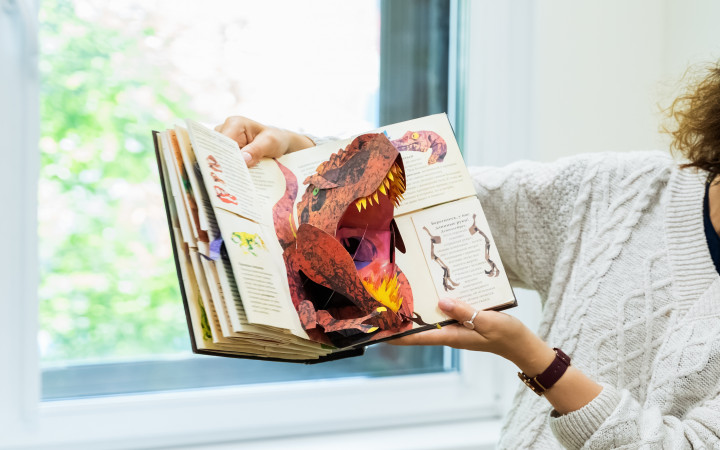Today’s Wonder of the Day was inspired by Jacob. Jacob Wonders, “How are pop up books made?” Thanks for WONDERing with us, Jacob!
Books and movies often seem to go hand-in-hand, don’t they? Who hasn’t read a great book and then been overjoyed to see it made into a fantastic movie. Movies can bring the stories in books to life in ways that rival the imagination.
If you’re a fan of movies, you might enjoy 3D movies. There’s nothing quite like seeing the action on the silver screen jump right out at you. But did you realize that there have long been books that could do something similar?
If you think back to your childhood, you’ll probably remember what we’re talking about. That’s right. Do you have any favorite pop-up books? Many people love these books. The action literally jumps right out at them as they turn the pages.
Pop-up books are just one type of a larger group of books known as movable or mechanical books. These include transformations, tunnel books, flaps, pull-tabs, pop-outs, and pull-downs. Some people would even add some types of three-dimensional greeting cards to the list.
Pop-up books come from the art of paper engineering. Many people associate them with origami because both involve paper folding. Unlike origami, however, pop-up books rely on scissors and glue. They’re also made from heavy card stock instead of thinner paper.
No one is sure when the first movable book was made. However, historians have uncovered a manuscript for an astrological book from 1306. The author was a Catalan mystic and poet named Ramon Llull. He made a revolving disc called a volvelle to help illustrate his astronomical theories.
Pop-up books have long been popular with children. However, the first movable books were made for adults. And they weren’t just entertainment! They were made to help readers understand developing scientific theories.
The first movable books meant to entertain children weren’t made until the 18th century. The earliest ones were made by hand by skilled craftsmen. Over time, these time-intensive processes were made easier by machines.
Children’s pop-up books became very popular all over the world. Publishers even began to reprint traditional fairy tales to add new pop-up features. These delighted many children and spurred them to read more. Today, hundreds of new pop-up books are made each year.
Making a pop-up book requires a lot of skill and planning. First, all the usual work that goes into a normal book is required. Once the storyline and illustrations are complete, the project goes to a paper engineer. They decide how many of what kind of movable elements should go into the book.
Paper engineers must be both imaginative and practical. They seek to make a book that’s both entertaining and durable. Great care must be given to designing pop-up elements that will not break over time.
Paper engineers must ask themselves which pieces need to be attached and in what way. How long should pull tabs be? How much glue should be used? Mathematics plays an important role in this phase of making pop-up books.
Some pop-up books make an impact with more than just paper. For example, small sound chips are sometimes used to play recorded messages or music, making books that please both the eyes and the ears!
Although modern printing presses can generate all the necessary pieces of pop-up books quickly and efficiently, many pop-up books are still assembled by hand. Sometimes it takes groups as large as 60 people to put together a single book in an assembly line that involves folding, cutting, inserting, connecting, and gluing!
Do you have any favorite pop-up books? Have you ever tried to make your own? It can be a long and difficult process, but it’s so much fun to hold and read your own creation!
Standards: CCRA.L.3, CCRA.L.6, CCRA.R.1, CCRA.R.2, CCRA.R.4, CCRA.R.10, CCRA.SL.1, CCRA.SL.2




